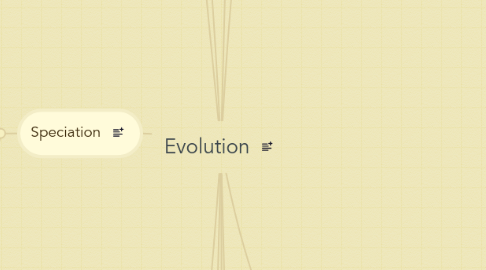
1. Speciation
1.1. Forms of speciation
1.1.1. Allopatric speciation
1.1.1.1. 1. Geographic isolation
1.1.1.2. 2. different selection pressures
1.1.1.3. 3. reproductive isolation
1.1.2. sympatric speciation
1.1.2.1. no geographic isolation
1.1.2.2. speciation by polyploidy
1.1.2.3. habitat differentiation
1.1.2.4. sexual selection
1.1.2.5. requires reproductive barrier
1.1.3. adaptive radiation
1.1.3.1. annidation
1.1.3.1.1. E.g. Darwins Finches
1.1.3.2. Preconditions
1.1.3.2.1. little competition
1.1.3.2.2. allopatric speciation occured before
1.1.3.2.3. different niches available
1.2. factors
1.2.1. hybridity
1.2.1.1. Barriers
1.2.1.1.1. postzygotic
1.2.1.1.2. prezygotic
1.2.2. isolation
1.2.2.1. habitat
1.2.2.2. temporal
1.2.2.3. behavioral
1.2.2.3.1. E.g. singing birds
1.2.2.4. mechanical
1.2.2.5. gametic
2. population
2.1. ideal population
2.1.1. extremely large population size
2.1.2. no gene flow
2.1.3. no mutations
2.1.4. random mating / panmixia
2.1.5. no natural selection
2.1.6. no change of allele frequncies
2.1.6.1. no development
2.2. real population
2.2.1. not ideal
2.3. gene pool changes by
2.3.1. gene drift
2.3.1.1. founder effect
2.3.1.1.1. migration of a part of the population
2.3.1.2. bottleneck effect
2.3.1.2.1. reduction of the population
2.3.1.3. effects
2.3.1.3.1. stronger in smaller populations
2.3.1.3.2. allele frequency can change randomly
2.3.1.3.3. can lead to loss of variation
2.3.1.3.4. can cause harmful alleles to become fixed
2.3.2. gene flow
2.3.2.1. exchange between other gene pools
2.3.2.1.1. source of new varation for one gene pool
2.3.2.1.2. reduces differences between gene pools
2.3.2.2. immigration
2.3.2.3. emigration
2.3.3. geographical barriers
2.3.4. selection
2.3.4.1. mate selection
2.3.4.2. natural selection
2.3.5. variations
3. Variation
3.1. mutation
3.1.1. types
3.1.1.1. chromosomal mutation
3.1.1.2. gene mutation
3.1.1.3. genomic mutation
3.1.2. characteristics
3.1.2.1. spontaneously
3.1.2.2. undirected (no prediction)
3.1.2.3. no targeted change
3.1.2.4. low in animals and plants
3.1.2.5. high in microorgansims and viruses
3.1.2.6. often negative
3.1.2.7. could have no effect -> neutral
3.2. sexual recombination
3.2.1. origin of genetic variation
3.2.2. crossing over of chromosomes in meiosis
3.2.3. independent assortment of chromosomes in meiosis
3.3. predisposition/preadaptaion
3.3.1. changed before it was benificial
4. reproduction
4.1. sexual
4.1.1. meisos
4.1.1.1. 2 divisions
4.1.1.2. daughter cells haploid
4.1.1.3. 4 daughter cells
4.1.1.4. daughter cells not identical
4.1.1.5. with crossing over
4.1.1.6. produces gametes
4.1.1.7. not identical
4.2. asexual
4.2.1. mitosis
4.2.1.1. 1 devision
4.2.1.2. daughter cells diploid
4.2.1.3. no crossing over
4.2.1.4. identical to parent
4.2.1.5. 2 daughter cells
4.2.1.6. daughter cells are identical
4.2.1.7. growth and replacement
5. classification of organisms
5.1. biological species concept
5.1.1. belong to the same species if actually or potentially producing fertile ofspring
5.2. morphological species concept
5.2.1. identical by morphological (anatomical) criteria
5.2.2. used for asexual species or fossils
5.3. phylogenetic trees
5.3.1. show time and amount of change
5.4. cladogram
5.4.1. guess of relateness by looking at common traits
5.4.2. does not take time and amount of change into account
5.5. Taxonomic classification
5.5.1. 1. Domain (e.g. Eukarya)
5.5.2. 2. Kingdom (e.g. Animalia)
5.5.3. 3. Phylum
5.5.4. 4. Class
5.5.5. 5. Order
5.5.6. 6. Family
5.5.7. 7. Genus
5.5.8. 8. Species
5.6. binominal classification
5.6.1. E.g. Homo sapiens
6. Theories
6.1. Darwin
6.1.1. natural selection
6.1.1.1. inheritance of new variation
6.1.1.2. overproduction
6.1.1.3. varition
6.1.2. Modern synthesis
6.1.2.1. theory refined/developed in light of modern biology
6.2. Lamarck
6.2.1. life evolves as environment changes
6.2.2. 1. "use and disuse"
6.2.2.1. body parts used extensively become larger and stronger
6.2.2.2. other body parts deteriorate
6.2.3. 2. inheritance of acquired characteristics
6.2.4. organisms have an innate drive to become more complex
7. Evidence
7.1. Fossils
7.1.1. transitonal fossils
7.1.1.1. archaeopteryx
7.1.2. living fossils
7.1.2.1. platypus
7.2. molecular biology
7.3. immunological Methods
7.4. similarities
7.4.1. Comparitive cytology
7.4.2. substances & processes
7.4.3. proteins
7.4.3.1. E.g. Insulin, cytochrome c, hemoglobin
7.4.4. DNA comparison
7.4.4.1. base sequences
7.4.4.2. DNA hybridisation
7.4.5. Comparative embryology
7.4.6. Biogeographical evidence
7.4.6.1. continental drift
7.4.7. novel forms / evo-devo
7.4.7.1. Hox genes
7.4.7.2. Evolution works with what is already present
7.4.7.3. multifunctionality & redundancy
7.4.7.4. modularity
7.4.8. rudimentary organs
7.4.8.1. E.g.
8. Comparative anatomy
8.1. related and similar looking
8.1.1. homology
8.1.1.1. criterion
8.1.1.1.1. criterion of position
8.1.1.1.2. criterion of continuity
8.1.1.1.3. criterion of specific quality
8.1.1.2. examples
8.1.1.2.1. pentadactyl limb
8.2. not closely related but similar looking
8.2.1. homoplasy
8.2.1.1. parallel evolution
8.2.1.1.1. differences to convergent evolution
8.2.1.2. convergent evolution
8.2.1.2.1. analogy
8.2.1.2.2. dolphin - shark
9. selection
9.1. Modes
9.1.1. disruptive
9.1.2. directional
9.1.3. stabilizing
9.2. factors
9.2.1. abiotic
9.2.1.1. humidity
9.2.1.2. temperature
9.2.1.3. wind
9.2.1.4. salinity
9.2.1.5. aridity
9.2.1.6. light conditions
9.2.1.7. poisons
9.2.2. biotic
9.2.2.1. intraspecific selection
9.2.2.1.1. sexual selection
9.2.2.2. interspecific selection
9.2.2.2.1. mimesis
9.2.2.2.2. mimicry
9.2.2.2.3. camouflage
9.2.2.2.4. warning signals
9.2.2.2.5. heterozygous advantage
9.2.2.3. Predation
9.2.2.4. Competition
9.2.2.5. Diseases
10. Basics
10.1. factors
10.1.1. mutation and recombination
10.1.2. selection
10.1.3. gene flow
10.1.4. genetic drift
10.1.5. isolation
10.2. Descent with modification
10.3. coevolution
10.3.1. complementary evolution of closely associated organisms
10.4. coadaptation
10.4.1. correlated adaptation so that mutual relationships can persist
10.4.2. increase the effectiveness of the relationship

